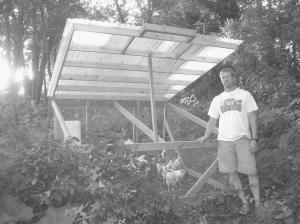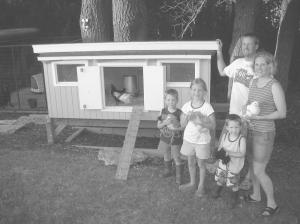2007 - Volume #31, Issue #1, Page #40
[ Sample Stories From This Issue | List of All Stories In This Issue | Print this story
| Read this issue]
Backyard Meat Machine Feeds Family, Friends
 |
 |
Twice a summer they pack 40 roosters into freezers for themselves, their friends and neighbors. They also produce plenty of eggs for their growing family. Best of all, their three young children are learning the responsibility and rewards of take care of animals.
"The kids do the feeding, fill the waterers, collect the eggs and catch any birds that get out," says Rochelle. "We sold one batch of chickens just by word of mouth and are using the money to start college funds for the kids."
Al used his woodworking skills to put together the coops in the backyard of their rural residence.
The chicken coop is an 8 by 8-ft. pen that's 4 ft. tall at the front and slopes to 3 ft. at the back. The cedar frame is covered with chicken wire. Cedar reduces weight and holds up well to the weather. Clear plastic roofing panels protect the birds yet still let in light. Skids made from pressure-treated 2 by 4's make it easy to move the pen around. The open bottom lets the birds pick and scratch, clearing out weeds and bugs as they go. A 3 by 3-ft. door on the front side is big enough for the kids to get in and fill the feeder and waterer, while hinges on the roof's front side let Al or Rochelle lift it up from the back for easy entrance.
"The pen gives each rooster about 1 1/2 sq. ft of space, which seems to work pretty well," says Al. "Having access to the weeds seems to help with their tendency to peck at each other."
By the time the chickens are four weeks old, the Gathjes are moving the pen every other day.
Last year the Gathjes got their first batch of 40 White Rock chicks in late May just as school ended. By mid August, they were gone, and a second set of chicks had arrived. The second batch is fast growing Cornish Rock chicks that reached 5 to 6 lbs. at 8 weeks. The birds are processed at an area plant, vacuum packed and flash frozen. Processing costs $2.10 per bird, and though they could do it themselves, Al and Rochelle agree the professional handling is worth it.
"They will last a year in the freezer with no freezer burn," says Al. "We spend about $1.25 a lb. for the finished meat and that includes processing and packaging."
"We find we get so many more meals off these home raised birds than store bought," says Rochelle.
When the Gathjes aren't eating home raised chicken this winter, they'll be eating eggs. They raise pullets in a second 40 by 88-in. coop.
The front end of the coop is 35 in. tall and the back 27 in. Framing is 2 by 4's, and the siding is tongue and groove pine boards.
"I got a little carried away with the siding," says Al, admitting that the building looks more like a fine cabinet than a chicken coop.
The 1/2-in. hardware cloth screen door keeps out raccoons. The roof is extended over the front to keep rain out and provide ventilation with more screening between the roof joists and the front and rear walls. CDX plywood was attached to the bottom of the coop with sheetrock screws so it can be replaced over time.
The hens handle Minnesota's winter weather just fine. "We use a water heater and a heat lamp when it gets real cold. Last year we hit 20¦ below zero one weekend, and they were fine."
Contact: FARM SHOW Followup, Al and Rochelle Gathje, 26205 Gladiola Lane, Lanesboro, Minn. 55949 (ph 507 467-3579).

Click here to download page story appeared in.

Click here to read entire issue
To read the rest of this story, download this issue below or click here to register with your account number.




